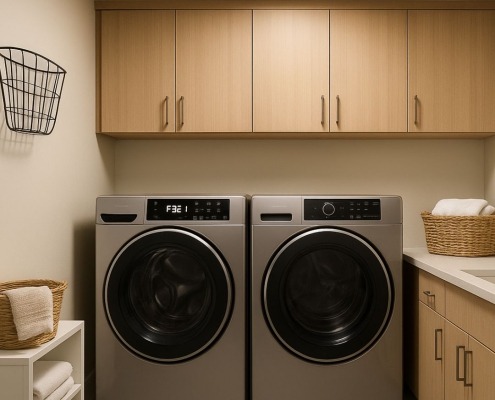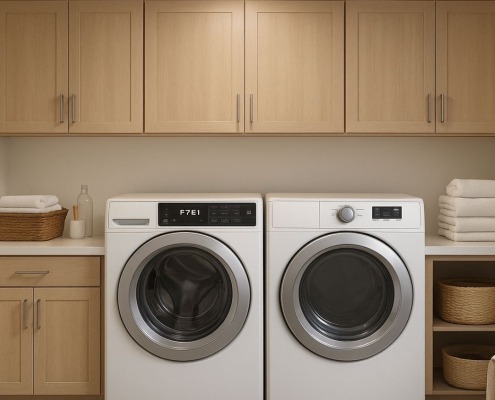How to replace a Whirlpool washing machine timer
Steven E / Tuesday April 22, 2025
Is your Whirlpool washer leaving you in a spin with malfunctioning cycles or unresponsive controls? Don’t worry—our step-by-step guide will show you just how simple it is to replace the timer and get your laundry routine back on track. Plus, watch our handy how-to video below to see the entire process in action!
Looking for the right part? Enter your appliance model number below to find the exact match and get your appliance running like new again!
On a Whirlpool washer, the timer is responsible for controlling the cycles and durations of various operations, allowing your washer to perform different functions at specific times.
Common signs that indicate the need for replacement include malfunctioning cycles, failure to advance, or non-functioning controls.
You can find a replacement timer here. If you need other replacement parts for your Whirlpool washer, just enter your model number at AppliancePartsPros.com to find them. It’s that easy! Most orders arrive in just two business days, and we have thousands of guides to show you how to install your new parts.
Watch here: How To: Whirlpool/KitchenAid/Maytag Timer WP22001530
The information in this article may not apply to your specific appliance model. We recommend consulting your manufacturer’s documentation or contact us with any questions.
Tools and materials
- Replacement part (make sure it’s compatible with your model before installing)
- Flathead screwdriver
- 5/16″ nut driver
- Phillips screwdriver
- Needle nose pliers
The specific tools required may vary depending on the model of your appliance and the type of fasteners used on it.
Safety precautions
When working on any appliance, remember to keep safety first. Here are some tips to keep in mind:
- Always power off and unplug your appliance or switch off the circuit breaker before attempting any maintenance or replacement work. This keeps you safe by preventing any risk of injury from electric shock.
- Turn off the water supply at the outlet before beginning repairs to any appliance parts that hold water. Have towels ready for any residual water in the system when removing parts.
- Wear insulated work gloves to protect your hands from sharp metal parts, pinching hazards and debris.
- Don’t test wiring with a multimeter for live voltage if you’re unfamiliar with how to prevent short circuiting when testing.
- When working with wires, avoid touching any exposed wires or terminals. If you need to touch a wire, use a non-conductive tool or wear insulating gloves to prevent electrical shock.
- Take your time and don’t rush while working to prevent accidents and personal injuries.
- Work in a well-lit area so you can clearly see and access the interior parts.
- Clear your workspace of clutter and other obstacles. Keep children and pets away from the work area.
- Never work on internal parts with bare wet hands. Make sure the work area is completely dry.
- Check your user manual to see if there are specific installation or safety instructions for your part or appliance.
- Be gentle when handling or removing parts. Excessive force might damage the appliance or cause injury.
- Wear safety glasses when working with chemicals, dust or cleaning large debris to prevent injury.
- If the appliance has recently been used, give it plenty of time for any heating parts to cool down before working on it.
- Take pictures or make a note of wiring connections before disconnecting to prevent any problems with reassembly.
Replacement steps
Step 1: Disassembly
- Use a flathead screwdriver to carefully get behind the knob cap. Gently pop off the knob cap.
- Use a flathead screwdriver to help pop off the clip located behind the timer knob. Take care not to lose the clip.
- Pull the timer knob off. Be careful as there is a spring behind it.
- Pull off the knob dial.
- Use a 5/16 inch nut driver to remove the screws that secure the timer to the console. Set aside the screws for reassembly.
- Use a Phillips screwdriver to remove the screws that hold the console together.
- Only remove the inner screws, leaving the outer ones in place as they hold the end cap.
- Carefully rotate the console forward after removing the inner screws. This allows access to the timer and wire harness.
- Locate the timer wiring harness and squeeze the locking tabs on each side.
- Remove the wiring harness off the timer.
- Remove the timer off the washer.
Step 2: Reassembly
- Take the new timer and align it with the opening in the console.
- Insert the timer shaft through the opening while holding the timer in place.
- Install the wiring harness and plug it onto the new timer. Make sure the wiring locks on securely for a good connection.
- Lift the console back up onto the timer.
- Align the tabs and rotate the console up.
- Use the 5/16 inch nut driver to tighten the screws and hold the timer in place.
- Lift the control panel back up onto the console. Align the tabs properly.
- Use a Phillips screwdriver to insert the screws and secure the control panel.
- Make sure the indicator pointer on the timer dial is lined up with the long side of the pin.
- Press the timer dial down, making sure it goes all the way down.
- Place the spring on if needed, then position the knob over it.
- Push the knob down into place and hold it to put the clip back on.
- Use small needle-nose pliers to push the clip into the recess on the end of the timer shaft.
- Align the four tabs on the cover with the openings in the knob.
- Push the cover into place.
- Plug in the washer, reconnect the water supply and run a test to check for any problems.
Additional information
Thanks for reading! We hope this guide helped you replace the timer on your Whirlpool washer.
If you still need some replacement parts, grab your model number and head over to AppliancePartsPros.com. We offer over two million parts and most orders arrive in two business days. If you need some help with finding the right part or placing an order, you can contact our team at 1 (877) 477-7278.
While you’re waiting for your new part to arrive, you can explore our DIY blog and watch thousands of video tutorials on our YouTube channel.
Be sure to follow us on Facebook, Twitter and Instagram to see our latest repair guides!
With nearly a decade of experience in providing top-notch customer service regarding appliance parts and repair, Steven enjoys sharing practical advice, troubleshooting tips, and interesting information to help readers stay informed.





